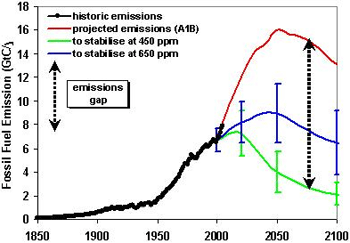400% increase in carbon dioxide emissions growth since 1990s
400% increase in carbon dioxide emissions growth since 1990s
mongabay.com
November 13, 2006
Carbon dioxide emissions from fossil fuel combustion are currently increasing four times faster than they were in the 1990s said scientists meeting at the Beijing Conference on Global Environment Change. Scientists from the Earth System Science Partnership (ESSP) warned that growing emissions put the Earth at risk of catastrophic climate change and urged governments to take immediate action to reduce emissions.
ESSP says that despite efforts to reduce carbon emissions, the global growth rate of CO2 was 3.2% between 2000 and 2005 compared to 0.8% during the 1990s. The data will soon be published by the Global Carbon Project (www.globalcarbonproject.org), a component of the ESSP.
“This is a very worrying sign”, said Dr Mike Raupach, Chair of the Global Carbon Project. “It indicates that recent efforts to reduce emissions have virtually no impact on emissions growth and that effective caps are urgently needed.”
 CO2 global emissions gap. Courtesy of ESSP |
“On our current path, we will find it extremely difficult to rein in carbon emissions enough to stabilise the atmospheric CO2 concentration at 450 ppm and even 550 ppm will be a challenge,” said Dr Josep Canadell, Executive Director of the Global Carbon Project. “At some point in the near future, we will miss the boat in terms of achieving acceptable levels of carbon dioxide in the atmosphere.”
The scientists warned that even when anthropogenic emissions do begin to decrease, atmospheric carbon dioxide levels will continue to climb for up to as much as a century due to thermal inertia, or their capacity to store heat. Thus the effects from past emissions are not entirely apparent today.
Current dioxide levels are 27 percent higher than at any point in the last 650,000 years, according to research into Antarctic ice cores published a year ago in the journal Science. Meanwhile researchers at NASA, the World Meteorological Organization (WMO) and the National Oceanic and Atmospheric Administration (NOAA) said that 2005 was the warmest year on record.
Most emissions growth is coming from developing economies, especially China. Last week an International Energy Agency report said that China’s output of carbon dioxide may surprass that of the United States by 2009, about a decade earlier than previous estimates. China currently ranks second behind the United States in carbon dioixde emissions, but rapid economic growth, fueled heavily by coal, is spurring a dramatic rise in greenhouse gas pollution. China’s emissions growth is one of the big reasons why the United States and Australia have refused to sign the Kyoto Protocol which calls for emissions limits for industrialized countries but none for developing economies including China, India, and Brazil.